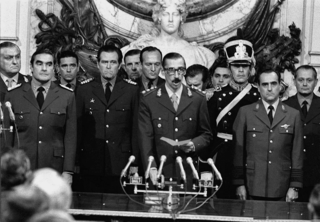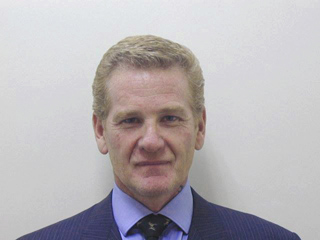Related Research Articles

Communications in Argentina gives an overview of the postal, telephone, Internet, radio, television, and newspaper services available in Argentina.

Channel 13 is an Argentine free-to-air television network and the flagship station of the network of the same name, located in the capital of Argentina, Buenos Aires. It is owned by Grupo Clarín through Artear.

Clarín is the largest newspaper in Argentina and the second most circulated in the Spanish-speaking world. It was founded by Roberto Noble in 1945, published by the Clarín Group.

Telecom Argentina S.A. is the major local telephone company for the northern part of Argentina, including the whole of the city of Buenos Aires. Briefly known as Sociedad Licenciataria Norte S.A., it quickly changed its name, and is usually known as simply "Telecom" within Argentina.

Promotora de Informaciones, S.A. (PRISA) is a Spanish media conglomerate headquartered in Madrid, Spain. It is one of the largest media companies in Spain and all of Latin America, producing a wide variety of educational, cultural and informative content. PRISA owns a portfolio of newspapers, magazines, radio stations, and television networks. The majority subsidiaries and brands of the company are El País, Cadena SER, and Santillana.
Vocento, S.A., also known as Grupo Vocento, is a Spanish mass media group. Its flagship daily newspaper is the conservative and monarchist ABC, also publishing El Correo. Vocento was created in 2001 upon the merger of Grupo Correo with Prensa Española, the publisher of ABC. The group is also a player in the regional press sector, mainly owing to former properties of Correo. Through Net TV, the group also owns a DDT license, which is leased to Paramount Network and Disney Channel.
David Martínez Guzmán is a Mexican investor who is the founder and managing partner of Fintech Advisory. This firm specializes in corporate and sovereign debt. Fintech Advisory has offices in London and New York City, and he currently divides his time between those two cities.

The 1976 Argentine coup d'état that overthrew Isabel Perón as President of Argentina on 24 March 1976, while having some right-wing elements, such as its emphasis on order and security, was not a traditional right-wing coup and did not adhere to a specific ideology. A military junta was installed to replace her; this was headed by Lieutenant General Jorge Rafael Videla, Admiral Emilio Eduardo Massera and Brigadier-General Orlando Ramón Agosti. The political process initiated on 24 March 1976 took the official name of "National Reorganization Process", and the junta, although not with its original members, remained in power until the return to the democratic process on 10 December 1983. The coup was planned and executed within the framework of the Condor Plan, a clandestine system of repressive coordination between Latin American countries promoted by the United States, as part of the national security doctrine, which generalized dictatorships in Latin America in order to maintain the control over those countries during the Cold War.
La Razón was a local newspaper distributed in the public transport in Buenos Aires, Argentina.

Francisco de Narváez Steuer, known as El Colorado or Pancho, is a Colombian-born naturalized Argentine businessman, politician who ran for governor of Buenos Aires Province on the Unión PRO ballot in the 2007 elections in Argentina. He was a member of the Argentine Chamber of Deputies until late 2015.

Ernestina Laura Herrera de Noble was a prominent Argentine publisher and executive. She was the largest shareholder of the Grupo Clarín media conglomerate and director of the flagship Clarín newspaper. She was the first woman to become director of a mainstream newspaper in South America.
Unidad Editorial, S.A. is a Spanish media company. It owns the newspapers El Mundo, Expansión and Marca. It is primarily owned by the Italian holding RCS MediaGroup.

Grupo Clarín S.A. is the largest media conglomerate in Argentina.

Radio in Argentina is an important facet of the nation's media and culture. Radio, which was first broadcast in Argentina in 1920, has been widely enjoyed in Argentina since the 1930s. Radio broadcast stations totaled around 150 active AM stations, 1,150 FM stations, and 6 registered shortwave transmitters. An estimated 24 million receivers were in use in 2000.

The Argentine Governments of Néstor Kirchner and Cristina Fernández de Kirchner had several conflicts with major media groups. Kirchner accused the Clarín Group, La Nación, Perfil, and related media of having promoted their overthrow.

José Luis Manzano is an Argentine businessman and former politician. He is currently a partner in the second largest multimedia group in his country, Grupo América, and has investments in several economic sectors, including energy, wine, and clothing. During his time in Argentine politics, Manzano was known as a power broker and negotiator and one of the architects of the success of the Menem government.

A number of cacerolazos, pot-banging protests, took place in several cities of Argentina on September 13 and November 8, 2012. The first, in September 13, was a national protest against the policies of the president Cristina Fernández de Kirchner. The protests generated significant repercussions in local politics. The second, on November 8, was another much more massive protest in several cities in Argentina, including Buenos Aires, Córdoba, Rosario, Mendoza, Olivos, among many others throughout Greater Buenos Aires and other regions. There were also protests in Argentine embassies and consulates in cities such as New York, Miami, Madrid, Sydney, Bogotá, Santiago and Barcelona, among others. Its complaints were almost the same, but the difference in size was very big. The protests are considered not only a call to Kirchnerism, but also to the opposition, because they do not have a strong leader.
Relato K is the name given by their critics to the alleged propaganda that promotes Kirchnerism in Argentina.

Grupo América, formerly known as Grupo UNO Medios, and also known as the Vila-Manzano Group, is a multimedia company in Argentina created by the Mendoza entrepreneurs Daniel Vila and the ex-politician and businessman José Luis Manzano. Is one of the owners of América TV, as well as many other TV channels, newspapers, radios and digital businesses throughout the country.

The National Communications Entity is the national communications and media regulator of Argentina. It was created by a presidential decree in 2016 and combines the former Federal Authority for Audiovisual Communication Services (AFSCA) and the Federal Authority for Information and Communication Technologies.
References
- 1 2 3 4 5 Becerra, Martín; Marino, Santiago; Mastrini, Guillermo (2012-02-29). "Mapping Digital Media: Argentina" (PDF). Open Society Foundation.
- 1 2 3 4 "Argentina". Digital News Report. Retrieved 2020-03-18.
- 1 2 "Media in Argentina: Newspapers, Internet, Radio & T.V." Retrieved 2020-03-18.
- 1 2 3 4 5 6 7 8 9 10 11 "Argentina's media: Big business for a few | Reporters without borders". RSF. 2019-04-10. Retrieved 2020-03-18.
- 1 2 "Argentina - History of the mass media". www.amautaspanish.com. Retrieved 2020-03-18.
- ↑ Seifert, Daniel (February 10, 2012). "Jugosa cosecha de Manzano". Noticias. Archived from the original on October 27, 2014. Retrieved 26 October 2014.
- ↑ "World Report 2019: Rights Trends in Argentina". Human Rights Watch. 2018-12-20. Retrieved 2020-03-18.